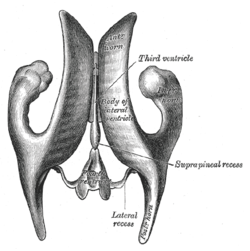Thefourth ventricleis one of the four connected fluid-filled cavities within thehuman brain.These cavities, known collectively as theventricular system,consist of the left and rightlateral ventricles,thethird ventricle,and the fourth ventricle. The fourth ventricle extends from thecerebral aqueduct(aqueduct of Sylvius) to theobex,and is filled withcerebrospinal fluid(CSF).
| Fourth ventricle | |
|---|---|
 Animation showing the fourth ventricle (in red) in relation to the ventricular system. | |
 Drawing of a cast of the ventricular cavities, viewed from above. (Fourth ventricle visible at bottom center.) | |
| Details | |
| Identifiers | |
| Latin | ventriculus quartus |
| MeSH | D020546 |
| NeuroNames | 621 |
| NeuroLexID | birnlex_1256 |
| TA98 | A14.1.05.701 |
| TA2 | 5966 |
| FMA | 78469 |
| Anatomical terms of neuroanatomy | |
The fourth ventricle has a characteristic diamond shape in cross-sections of the human brain. It is located within theponsor in the upper part of themedulla oblongata.CSF entering the fourth ventricle through the cerebral aqueduct can exit to thesubarachnoid spaceof thespinal cordthrough twolateral aperturesand a single, midlinemedian aperture.
Boundaries
editThe fourth ventricle has aroofat itsupper(posterior) surface and afloorat itslower(anterior) surface, and side walls formed by thecerebellar peduncles(nerve bundles joining the structure on the posterior side of the ventricle to the structures on the anterior side). The caudal tip of the fourth ventricle - where it becomes thecentral canal- is known as theobex;the obex is also a marker for the level of theforamen magnumof theskulland therefore is a marker for the imaginary dividing line between themedullaandspinal cord.
The superior portion of theroof(i.e. of the posterior edge) is formed, in the midline, by a thin lamina called thesuperior medullary velum,and laterally by thecerebellar peduncles.The inferior portion of theroofis formed superiorly by theinferior medullary veliand the vermis of theCerebellum(covered withchoroid plexus), and inferiorly by thetela.The inferior portion of theroofis where CSF can escape the ventricle through three openings: Near each of the three corners of the inferior roof there is an opening into thecisterna magna,the caudal opening being theforamen Magendie,while the lateral openings are theforamina of Luschka.Therefore, the fourth ventricle is the connector between the ventricular system (where CSF is produced) and the subarachnoid space (where CSF is absorbed). Theroofrises (i.e. posteriorly) to a peak, known as thefastigium(Latin for "summit" );[1]thefastigial nucleuslies immediately above the roof of the fourth ventricle, in the cerebellum.[2]
Thefloor(i.e. the anterior edge) of the fourth ventricle constitutes therhomboid fossa,and comprises a number of general features. A sulcus - themedian sulcus- extends the length of the ventricle (from thecerebral aqueductof the midbrain to the central canal of the spinal cord), dividing the floor into right and left halves. Each half is further divided by a further sulcus - thesulcus limitans- along a line parallel to the median sulcus; within the floor, motor neurons are located medially of the sulcus limitans, while sensory neurons are located laterally. The elevation between the median sulcus and sulcus limitans (i.e. the region for motor neurons), is known as themedial eminence,while the lateral region (i.e. that for the sensory neurons) is known as thevestibular area.The sulcus limitans bifurcates at either end - thesuperior foveacerebrally, and theinferior foveacaudally.
Theponsis located behind the middle and superior portion of thefloor.In the superior region of the pons is thelocus coeruleus,which due to its concentration ofnoradrenalinehas asky blueappearance, visible (in a colour closer to teal) through the floor of the ventricle, superiorly to the superior fovea. The internal part of thefacial nervebulges into the ventricle, forming thefacial colliculus,in the process of looping around theabducens nucleuswithin the inferior region of the Pons.
Themedulla oblongatais located behind the inferior portion of thefloor(and continues caudally of the ventricle).Medullary striaeemerge via the median sulcus and run transversely across the floor to become part of theinferior cerebellar peduncle.Thehypoglossal nucleusbulges into thefloor,creating thehypoglossal trigone,located slightly superiorly to the inferior fovea, within the median eminence. Thedorsal nucleus of vagus nerve,within the medulla oblongata, comprises cells that are spindle shaped, also creating a bulge—thevagal trigone—in the region of thefloorwhich overlies them; this is the region inferior of the inferior fovea.
Development
editThe ventricular system including the fourth ventricle, develops from thecentral canalof the neural tube. Specifically, the fourth ventricle originates from the portion of the tube that is present in the developingrhombencephalon.[3]During the first trimester of pregnancy the central canal expands into the lateral, third and fourth ventricles, connected by thinner channels.[4]Choroid plexusesappear in the ventricles which producecerebrospinal fluid.If the flow of fluid is blocked ventricles may become enlarged and causehydrocephalus.
Clinical significance
editThe floor of the fourth ventricle is a common location of anintracranialependymomain children.
Additional images
edit-
Transverse section of medulla oblongata below the middle of the olive.
-
Scheme ofroof of fourth ventricle.
-
Rhomboid fossa.
-
Median sagittal section of brain.
-
Drawing of a cast of the ventricular cavities, viewed from the side.
-
Diagram showing the positions of the three principal subarachnoid cisternæ.
-
Fourth ventricle
References
edit- ^Dr. M. A. (Toby) Arnold."Anatomy Glossary".Archived fromthe originalon 2017-03-01.Retrieved2015-07-28.
- ^Spierer, Ronen (2023)."The debated neuroanatomy of the fourth ventricle".Journal of Anatomy.243(4): 555–563.doi:10.1111/joa.13885.ISSN1469-7580.PMC10485575.PMID37170923.
- ^ Le, Tao; Bhushan, Vikas; Vasan, Neil (2010).First Aid for the USMLE Step 1: 2010 20th Anniversary Edition.USA:The McGraw-Hill Companies, Inc.pp.126.ISBN978-0-07-163340-6.
- ^Carlson, Bruce M. (1999).Human Embryology & Developmental Biology.Mosby. pp. 237–238.ISBN0-8151-1458-3.
External links
edit- Atlas image: n2a8p1at the University of Michigan Health System - "Fourth Ventricle, Sagittal Section, Medial View"
- Stained brain slice images which include the "fourth%20ventricle"at theBrainMaps project
- "Anatomy diagram: 13048.000-3".Roche Lexicon - illustrated navigator.Elsevier. Archived fromthe originalon 2012-07-22.